Analysis of Costantino Landslide Dam Evolution (Southern Italy) by Means of Satellite Images, Aerial Photos, and Climate Data
Abstract
:1. Introduction
- -
- the description of case histories (surely the most treated issue, with a countless number of cases described around the world);
- -
- -
- -
- -
2. Study Area
3. Materials and Methods
3.1. Climatic Characterization and Assessment of Wet/Drought Periods
3.2. Aerial and Satellite Imagery Database
4. Results
4.1. Climatic Analysis and Assessment of Wet/Drought Periods
4.2. Evolution of Lake Surface and of Landslide Dam
5. Discussion on Origin and Evolution of the Costantino Lake
- pimax = rainfall in the rainiest month of the year i (mm);
- Pi = yearly rainfall (mm);
- pi = mean monthly rainfall (mm);
- P = mean annual rainfall (mm).
6. Conclusions
- –
- The use of imagery dataset of different nature (aerial photos, orthophotos, and satellite images) allowed to study the evolution of the Costantino dam lake. The lake surface between 1983 and 2008 gradually decreased of 40% (from about 100,000 to 60,000 m2). After January 2009, a sudden decrease of the lake surface was observed in few months, leaving a very small lake of less than 8000 m2.
- –
- Climatic data from the most reliable rain gauges in the Costantino landslide dam area indicate a significant decreasing trend in annual and autumn-winter rainfalls, with some significant increase in summer months. The SPI index shows a notable increase in the length and frequency of droughts. The most severe droughts have occurred during the last two decades: this problem is common to many other mountain areas in the Mediterranean basin.
- –
- The use of basic empirical equations shows that the general reduction of rainfalls inevitably affects the erosion rates on the Bonamico catchment: the MFI index decreased of about 17% in the last three decades. This result agrees with those obtained in other areas of the Mediterranean basin (e.g. [75,76,77,78]), but is in contrast to findings in the Mediterranean Iberian peninsula, where some increase (+8.8%) of MFI was observed (e.g. [73]).
- –
- Despite the general decrease of both precipitation and rain erosivity index, the erosivity classes within the Bonamico basin remained ‘very severe/very high’ in the last decades. This indicates that the erosion and sediment transport processes played a key role in the filling up of the Costantino dam lake, at least up to 2008.
- –
- The use of multi-temporal image observations coupled with analysis of daily rainfalls enabled individuation causes of sudden changes in lake surface after January 2009: overtopping/dam failure processes related to heavy rainfall and floods that occurred in January 2009 deeply affected the threshold of the lake outlet. Satellite images visually show the result of these processes, which can be summarized in the removal of vegetation and the mobilization of dam materials along the riverbed downstream.
Acknowledgments
Author Contributions
Conflicts of Interest
References
- Schuster, R.L. Landslide Dams: Processes, Risk, and Mitigation; Geotechnical Special Publication; American Society of Civil Engineering: New York, NY, USA, 1986; Volume 3, p. 164. [Google Scholar]
- Costa, J.E.; Schuster, R.L. The formation and failure of natural dams. Geol. Soc. Am. Bull. 1988, 100, 1054–1068. [Google Scholar] [CrossRef]
- Evans, S.G. The formation and failure of landslide dams: An approach to risk assessment. Ital. J. Eng. Geol. Environ. 2006, 1, 15–19. [Google Scholar]
- Schuster, R.L. Landslide Dams in the Western United States. In Proceedings of the 4th International Conference and Field Workshop on Landslides, Tokyo, Japan, 23–31 August 1985; pp. 411–418. [Google Scholar]
- Costa, J.E.; Schuster, R.L. Documented Historical Landslide Dams from Around the World; Open-File Report; United States Department of the Interior Geological Survey: Vancouver, WA, USA, 1991; pp. 91–239.
- Cencetti, C.; Conversini, P.; Ribaldi, C.; Tacconi, P. Studio dei sistemi alveo—Pianura fluviale in relazione alle interazioni con fenomeni franosi di versante. Mem. Soc. Geol. Ital. 2001, 56, 249–263. [Google Scholar]
- Cencetti, C.; Conversini, P.; Marchesini, I.; Ribaldi, C.; Tacconi, P. Pericolosità dei fenomeni franosi che interferiscono con i sistemi alveo-pianura fluviale: Un approccio probabilistico. Ital. J. Eng. Geol. Environ. 2002, 1, 49–60. [Google Scholar]
- Cencetti, C.; De Rosa, P.; Minelli, A. A sensitivity analysis on main factors involved in the landslide dam phenomena. Ital. J. Eng. Geol. Environ. 2011, 1, 61–72. [Google Scholar]
- Pirocchi, A. Laghi di sbarramento per frana nelle Alpi: Tipologia ed evoluzione. Ric. Sci. Educ. Perm. 1991, 93, 127–136. [Google Scholar]
- Canuti, P.; Casagli, N.; Ermini, L. Inventory of landslide dams in the Northern Apennine as a model for induced flood hazard forecasting. In Managing Hydro-Geological Disasters in a Vulnerate Environment; Andah, K., Ed.; CNR-GNDCI Publication 1900; CNR-GNDCI-UNESCO (IHP): Perugia, Italy, 1998; pp. 189–202. [Google Scholar]
- Casagli, N.; Ermini, L. Geomorphic analysis of landslide dam of Northern Appenine. Trans. Jpn. Geomorphol. Union 1999, 20, 219–249. [Google Scholar]
- Tacconi Stefanelli, C.; Catani, F.; Casagli, N. Geomorphological investigations on landslide dams. Geoenviron. Dis. 2015, 2, 1–15. [Google Scholar] [CrossRef]
- Dunning, S.A.; Petley, D.N.; Rosser, N.J. Landslide dams: Causes, catastrophic failure prediction and downstream consequences. Geophys. Res. Abstr. 2005, 7, 06893. [Google Scholar]
- Hungr, O. Prospects for prediction of landslide dam geometry using empirical and dynamic models. Ital. J. Eng. Geol. Environ. 2006, 1, 151–155. [Google Scholar]
- Kuo, Y.S.; Tsang, Y.C.; Chen, K.T.; Shieh, C.L. Analysis of landslide dam geometries. J. Mt. Sci. 2011, 8, 544–550. [Google Scholar] [CrossRef]
- Dal Sasso, S.F.; Sole, A.; Pascale, S.; Sdao, F.; Bateman Pinzòn, A.; Medina, V. Assessment methodology for the prediction of landslide dam hazard. Nat. Hazards Earth Syst. Sci. 2014, 14, 557–567. [Google Scholar] [CrossRef]
- Cencetti, C.; De Rosa, P.; Fredduzzi, A. Evaluation of landslide dams hazard and risk: An application in Upper Tiber Valley (central Italy). Rend. Online Soc. Geol. Ital. 2015, 35, 54. [Google Scholar] [CrossRef]
- Costa, J.E. Floods from Dam Failures; Open-File Report n. 85-560; United States Department of the Interior Geological Survey: Vancouver, WA, USA, 1987; pp. 1–59.
- Ermini, L.; Casagli, N. Criteria for a preliminary assessment of landslide dam evolution. In Landslides—Proceedings of 1st European Conference on Landslides; Rybar, J., Stemberk, J., Wagner, P., Eds.; Balkema: Prague, Czech Republic, 2002; pp. 157–162. [Google Scholar]
- Ermini, L. Gli sbarramenti d’alveo da frane: Criteri speditivi per la stesura di scenari evolutivi derivanti dalla loro formazione. In Atti del 1° Congresso Nazionale AIGA (Chieti, 19–20 Febbraio 2003); Rendina Editore: Rome, Italy, 2003; pp. 355–367. [Google Scholar]
- Dong, J.J.; Tung, Y.H.; Chen, C.C.; Liao, J.J.; Pan, Y.W. Logistic regression model for predicting the failure probability of a landslide dam. Eng. Geol. 2011, 117, 52–61. [Google Scholar] [CrossRef]
- Peng, M.; Zhang, L.M. Breaching parameters of landslide dams. Landslides 2012, 9, 13–31. [Google Scholar] [CrossRef]
- Swanson, F.J.; Oyagi, N.; Tominaga, M. Landslide dam in Japan. In Landslide Dam: Processes Risk and Mitigation; Schuster, R.L., Ed.; Geotechnical Special Publication; American Society of Civil Engineers: New York, NY, USA, 1986; Volume 3, pp. 131–145. [Google Scholar]
- Moore, I.D.; Grayson, R.B.; Ladson, A.R. Digital terrain modelling: A review of hydrological, geomorphological, and biological applications. Hydrol. Process. 1991, 5, 3–30. [Google Scholar] [CrossRef]
- Ermini, L.; Casagli, N. Prediction of the behaviour of landslide dams using a geomorphological dimensionless index. Earth Surf. Processes Landf. 2003, 28, 31–47. [Google Scholar] [CrossRef]
- Fan, X.; van Westen, C.J.; Korup, O.; Gorum, T.; Xu, Q.; Dai, F.; Huang, R.; Wang, G. Transient water and sediment storage of the decaying landslide dams induced by the 2008 Wenchuan earthquake, China. Geomorphology 2012, 171, 58–68. [Google Scholar] [CrossRef]
- Tacconi Stefanelli, C.; Segoni, S.; Casagli, N.; Catani, F. Geomorphic indexing of landslide dams evolution. Eng. Geol. 2016, 208, 1–10. [Google Scholar] [CrossRef]
- Pingyi, Z.; Tianchi, L. Flash Flooding Caused by Landslide Dam Failure. In ICIMOD, Mountain Flash Floods; ICIMOD: Kathmandu, Nepal, 2000; Newsletter No. 38. [Google Scholar]
- Schuster, R.L. Outburst debris flows from failure of natural dams. In Proceedings of the 2nd International Conference on Debris-Flow Hazard Mitigation, Taipeh, Taiwan, 16–18 August 2000. [Google Scholar]
- Li, M.H.; Hsu, M.H.; Hsieh, L.S.; Teng, W.H. Inundation Potentials Analysis for Tsao-Ling Landslide Lake Formed by Chi-Chi Earthquake in Taiwan. Nat. Hazards 2002, 25, 289–303. [Google Scholar] [CrossRef]
- Korup, O.; Strom, A.L.; Weidinger, J.T. Fluvial response to large rock-slope failures: Examples from the Himalayas, the Tien Shan, and the southern alps in New Zealand. Geomorphology 2006, 78, 3–21. [Google Scholar] [CrossRef]
- Yoshino, K.; Uchida, T.; Shimizu, T.; Tamura, K. Geomorphic changes of a landslide dam by overtopping erosion. Ital. J. Eng. Geol. Environ. 2011, 797–804. [Google Scholar] [CrossRef]
- Fread, D.L. DAMBRK: The NWS Dam-Break Flood Forecasting Model; Hydrologic Research Laboratory, National Weather Service: Silver Spring, MD, USA, 1984.
- Fread, D.L. BREACH: An Erosion Model for Earthen Dam Failures; Hydrologic Research Laboratory, National Weather Service: Silver Spring, MD, USA, 1987.
- Fread, D.L. The NWS Dambrk Model: Theoretical Background/User Documentation; National Weather Service, NOAA: Silver Spring, MD, USA, 1991.
- Walder, J.S.; O’Connor, J.E. Methods for predicting peak discharge of floods caused by failure of natural and earthen dams. Water Resour. Res. 1997, 33, 2337–2348. [Google Scholar] [CrossRef]
- Tabata, S.; Ikeshima, T.; Inoue, K.; Mizuyama, T. Study on prediction of peak discharge in floods caused by landslide dam failure. J. Jpn. Soc. Eros. Control Eng. 2001, 54, 73–76. [Google Scholar]
- Cencetti, C.; Fredduzzi, A.; Marchesini, I.; Naccini, M.; Tacconi, P. Some considerations about the simulation of the breach channel erosion on landslide dams. Comput. Geosci. 2006, 10, 201–219. [Google Scholar] [CrossRef]
- Ishikawa, Y.; Irasawa, M.; Kuang, S.F. Study on prediction and countermeasures of flood disasters caused by landslide dam failure. J. Jpn. Soc. Eros. Control Eng. 1992, 45, 14–23. [Google Scholar]
- Schuster, R.L. Risk-reduction measures for landslide dams. Ital. J. Eng. Geol. Environ. 2006, 1, 9–13. [Google Scholar]
- Schuster, R.L.; Costa, J.E. Effects of landslide damming on hydroelectric projects. In Proceedings of the 5th International Association of Engineering Geology, Buenos Aires, Argentina, 20–25 October 1986; CRC Press: BOca Ratón, FL, USA, 1990; pp. 1295–1307. [Google Scholar]
- Ergenzinger, P. A conceptual geomorphological model for the development of a Mediterranean river basin under neotectonic stress (Buonamico basin, Calabria, Italy). In Erosion, Debris Flows and Environment in Mountain Regions; Walling, D.E., Davies, T.R., Hasholt, B., Eds.; International Association of Hydrological Sciences (IAHS): Wallingford, UK, 1992; Volume 209, pp. 51–60. [Google Scholar]
- Petrucci, O.; Polemio, M. Catastrophic geomorphological events and the role of rainfalls in South-Eastern Calabria (Southern Italy). In Proceedings of the 2nd EGS Plinius Conference on Mediterranean Storms, Siena, Italy, 16–18 October 2000; Editoriale Bios: Cosenza, Italy, 2000; pp. 449–459. [Google Scholar]
- Sorriso-Valvo, M.; Terranova, O. The Calabrian fiumara. Z. Geomorphol. 2006, 143, 105–121. [Google Scholar]
- Sorriso-Valvo, M. Mass Movements and Accelerated Erosion in the Buonamico Basin; Berliner Geowissenschaftliche Abhandlungen: Berlin, Germany, 1984. [Google Scholar]
- Guerricchio, A.; Melidoro, G. Segni premonitori e collassi delle grandi frane della valle della fiumara Buonamico (Aspromonte, Calabria). Geol. Appl. Idrogeol. 1973, 8, 315–346. [Google Scholar]
- Ibbeken, H.; Schleyer, R. Source and Sediment: A Case Study of Provenance and Mass Balance at an Activeplatemargin (Calabria, Southern Italy); Pangaea: Bremerhaven, Germany, 1991. [Google Scholar]
- Calcaterra, D.; Parise, M. Weathering in the crystalline rocks of Calabria, Italy, and relationships to landslides. Eng. Geol. Spec. Geol. Soc. Lond. 2010, 23, 105–130. [Google Scholar] [CrossRef]
- Delfino, A. L’Aspromonte; Falzea Editore: Reggio Calabria, Italy, 2006; p. 128. [Google Scholar]
- Cencetti, C.; De Rosa, P.; Fredduzzi, A. The Landslide Dam of Ventia Creek (Umbria, Central Italy). In Engineering Geology for Society and Territory—Volume 2. Landslide Processes; Lollino, G., Giordan, D., Crosta, G.B., Corominas, J., Azzam, R., Wasowski, J., Sciarra, N., Eds.; Springer: Cham, Switzerland, 2015; pp. 1125–1128. [Google Scholar]
- ISPRA, CARG Project (Geological Cartography). Geological Map “Foglio 603 Bovalino”; ISPRA—Servizio Geologico d’Italia: Rome, Italy, 2005. [Google Scholar]
- Cambi, C.; Valigi, D.; Di Matteo, L. Hydrogeological study of data-scarce limestone massifs: The case of Gualdo Tadino and Monte Cucco structures (Central Apennines, Italy). Boll. Geofis. Teor. Appl. 2010, 51, 345–360. [Google Scholar]
- Di Matteo, L.; Valigi, D.; Cambi, C. Climatic characterization and response of water resources to climate change in limestone areas: Some considerations on the importance of geological setting. J. Hydrol. Eng. 2013, 18, 773–779. [Google Scholar] [CrossRef]
- Peterson, T.C.; Easterling, D.R.; Karl, T.R.; Groisman, P.; Nicholls, N.; Plummer, N.; Torok, S.; Auer, I.; Boehm, R.; Gullett, D.; et al. Homogeneity adjustments of in situ atmospheric climate data: A review. Int. J. Climatol. 1998, 18, 1493–1517. [Google Scholar] [CrossRef]
- Mann, H.B. Nonparametric tests against trend. Econometrica 1945, 13, 245–259. [Google Scholar] [CrossRef]
- Kendall, M.G. Rank Correlation Methods; Griffin: London, UK, 1975. [Google Scholar]
- McKee, T.B.; Doesken, N.J.; Kleist, J. The relationship of drought frequency and duration to time scales. In Proceedings of the 8th Conference of Applied Climatology, Anaheim, CA, USA, 17–22 January 1993; American Meteorological Society: Boston, MA, USA, 1993; pp. 179–184. [Google Scholar]
- Edwards, D.C.; McKee, T.B. Characteristics of 20th Century Drought in the United States at Multiple Time Scales. Available online: http://ccc.atmos.colostate.edu/edwards.pdf (accessed on 25 January 2017).
- WMO. Experts Agree on a Universal Drought Index to Cope with Climate Risks. WMO Press Release No. 872. 2009. Available online: http://www.wmo.int/pages/prog/wcp/agm/meetings/wies09/documents/872_en.pdf (accessed on 5 March 2017).
- Buttafuoco, G.; Caloiero, T. Drought events at different timescales in southern Italy (Calabria). J. Maps 2014, 10, 529–537. [Google Scholar] [CrossRef]
- Vicente-Serrano, S.M.; López-Moreno, J.I. Hydrological response to different time scales of climatological drought: An evaluation of the standardized precipitation index. Hydrol. Earth Syst. Sci. 2005, 9, 523–533. [Google Scholar] [CrossRef]
- Naresh Kumar, M.; Murthy, C.S.; SeshaSai, M.V.R.; Roy, P.S. On the use of Standardized Precipitation Index (SPI) for drought intensity assessment. Meteorol. Appl. 2009, 16, 381–389. [Google Scholar] [CrossRef]
- Tigkas, D.; Vangelis, H.; Tsakiris, G. DrinC: A software for drought analysis based on drought indices. Earth Sci. Inform. 2015, 8, 697–709. [Google Scholar] [CrossRef]
- Tsakiris, G.; Vangelis, H. Establishing a Drought Index Incorporating Evapotranspiration. Eur. Water 2005, 9, 3–11. [Google Scholar]
- Coscarelli, R.; Gaudio, R.; Caloiero, T. Climatic trends: An investigation for a Calabrian basin (southern Italy). IAHS Publ. 2004, 286, 255–266. [Google Scholar]
- Cotecchia, V.; Casarano, D.; Polemio, M. Characterisation of rainfall trend and drought periods in southern Italy from 1821 to 2001. In Proceedings of 1st Italian-Russian Workshop New Trends in Hydrology; Gaudio, R., Ed.; CNR-GNDCI Publ. 2823; CNR: Rome, Italy, 2004. [Google Scholar]
- Ferrari, E.; Terranova, O. Non-parametric detection of trends and change point years in monthly and annual rainfalls. In Proceedings of 1st Italian-Russian Workshop New Trends in Hydrology; Gaudio, R., Ed.; CNR-GNDCI Publ. 2823; CNR: Rome, Italy, 2004. [Google Scholar]
- Polemio, M.; Casarano, D. Climate change, drought and groundwater availability in southern Italy. In Climate Change and Groundwater; Dragoni, W., Ed.; Special Publications, No. 288; Geological Society: London, UK, 2008; pp. 39–51. [Google Scholar]
- Caloiero, T.; Coscarelli, R.; Ferrari, E.; Mancini, M. Trend detection of annual and seasonal rainfall in Calabria (Southern Italy). Int. J. Climatol. 2011, 31, 44–56. [Google Scholar] [CrossRef]
- Caloiero, T.; Sirangelo, B.; Coscarelli, R.; Ferrari, E. An Analysis of the Occurrence Probabilities of Wet and Dry Periods through a Stochastic Monthly Rainfall Model. Water 2016, 8, 39. [Google Scholar] [CrossRef]
- Fournier, F. Climat et Erosion; Presses Universitaires de France: Paris, France, 1960. [Google Scholar]
- Arnoldus, H.M.J. An approximation of the rainfall factor in the universal Soil Loss Equation. In Assessment of Erosion; FAO Land and Water Development Division, Wiley & Sons: Chichester, UK, 1980; pp. 127–132. [Google Scholar]
- De Luis, M.; Gonzalez-Hidalgo, J.C.; Longares, L.A.; Stepanek, P. Seasonal precipitation trends in Mediterranean Iberian Peninsula in second half of XX century. Int. J. Climatol. 2009. [Google Scholar] [CrossRef]
- European Environment Agency. CORINE—Soil Erosion Risk and Important Land Resources in the Southern Regions of the European Community; Final Report EUR 13233-EN; Publications Office of the European Union: Luxembourg, Luxembourg, 1992.
- Dragoni, W.; Valigi, D. Some considerations regarding climatic change and specific erosion in Central Italy. In Geomorphology and Global Environmental Change; Slaymaker, O., Ed.; John Wiley & Sons: Hoboken, NJ, USA, 2000; pp. 197–208. [Google Scholar]
- Gullà, G.; Antronico, L.; Borrelli, L.; Caloiero, T.; Coscarelli, R.; Iovine, G.; Nicoletti, P.G.; Pasqua, A.A.; Petrucci, O.; Terranova, O. Indicazioni conoscitive e metodologiche connesse all’evento di dissesto idrogeologico dell’autunno-inverno 2008–2009 in Calabria. Geol. Calabria 2009, 10, 4–21. [Google Scholar]
- Angulo-Martınez, M.; Beguerıa, S. Do atmospheric teleconnection patterns influence rainfall erosivity? A comparison between NAO, MO and WEMO in NE Spain, 1955–2006. J. Hydrol. 2012, 450, 168–179. [Google Scholar] [CrossRef]
- Meddi, M. Sediment transport and rainfall erosivity evolution in twelve basins in Central and Western Algeria. J. Urban Environ. Eng. 2013, 7, 253–263. [Google Scholar] [CrossRef]
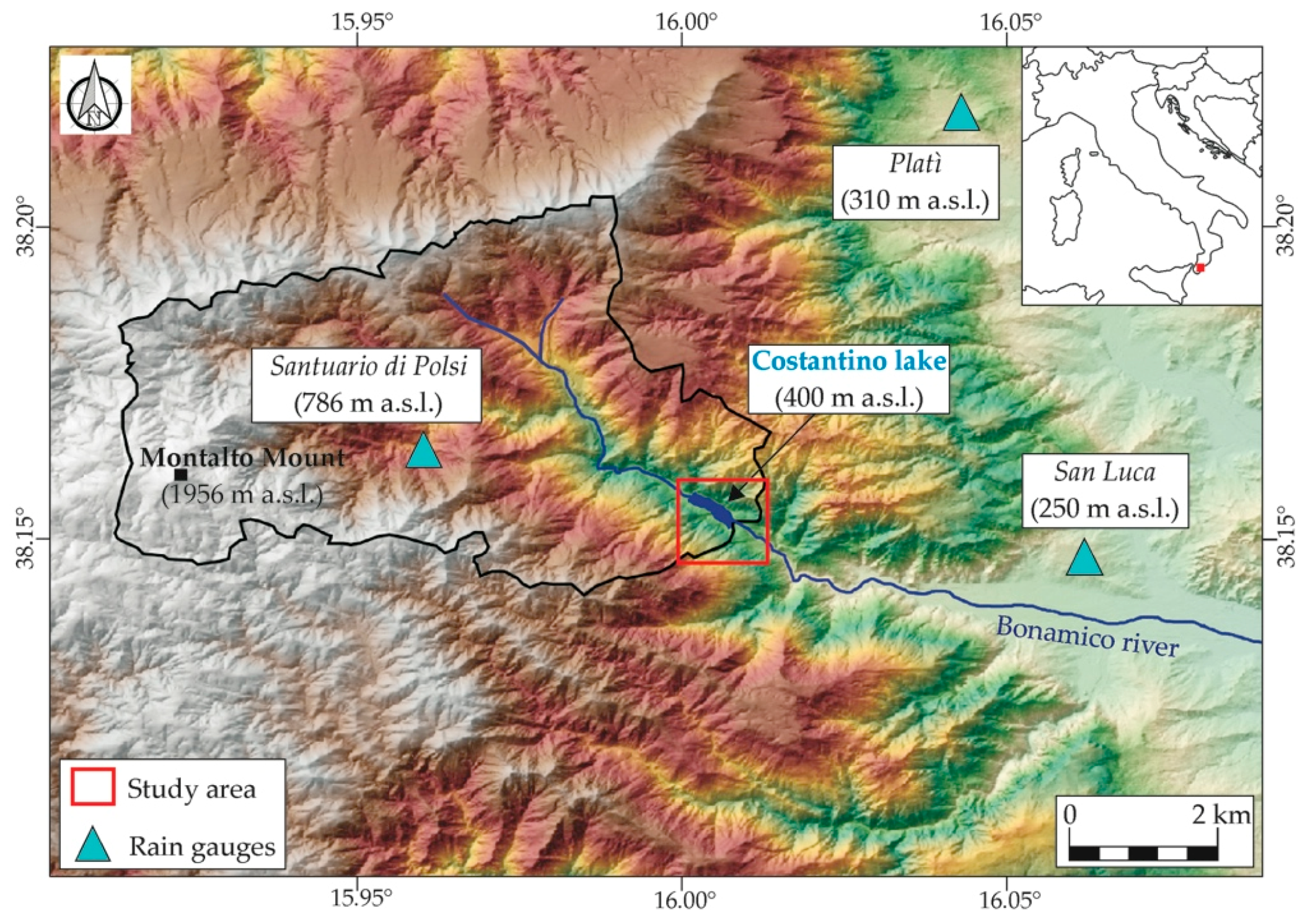
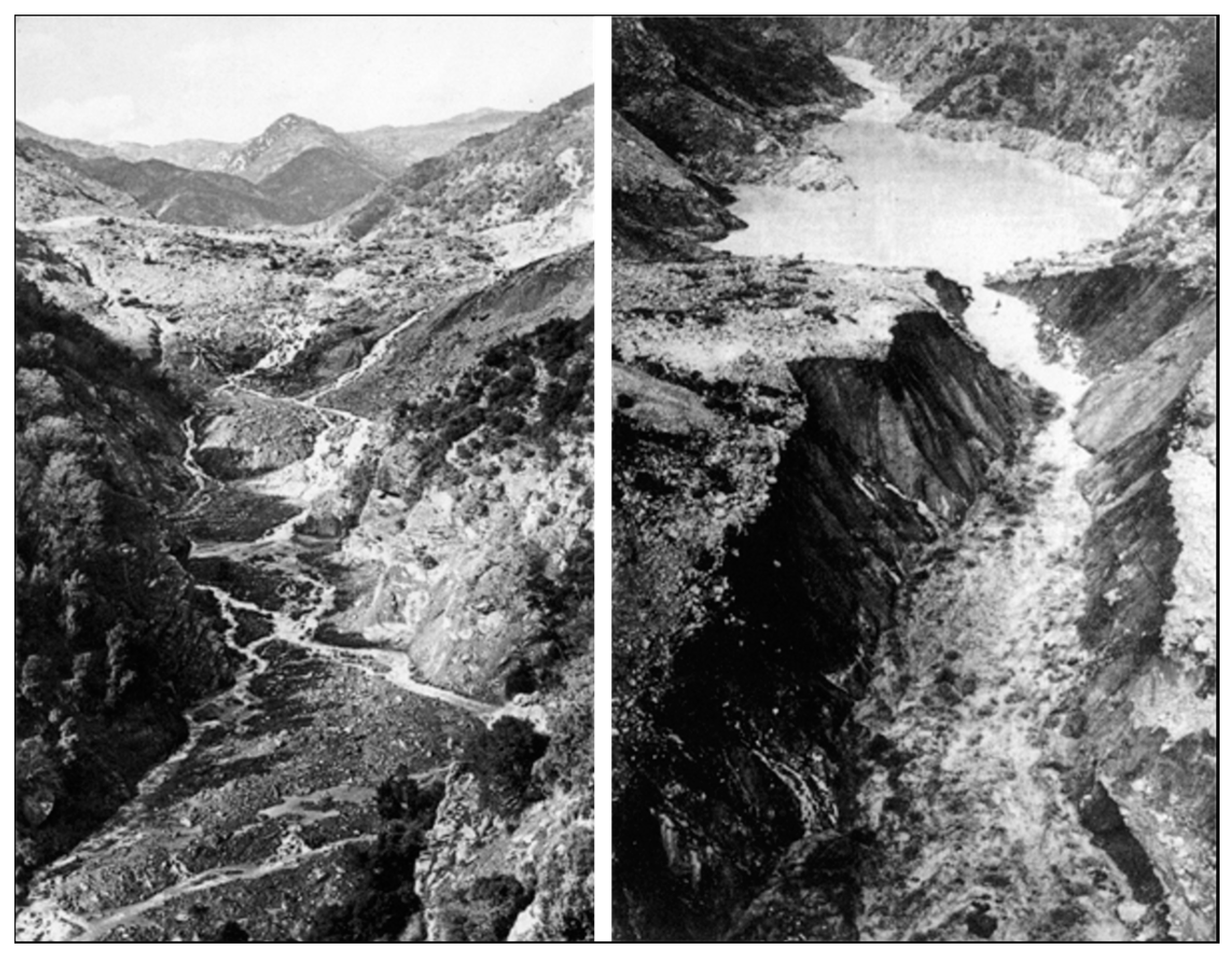

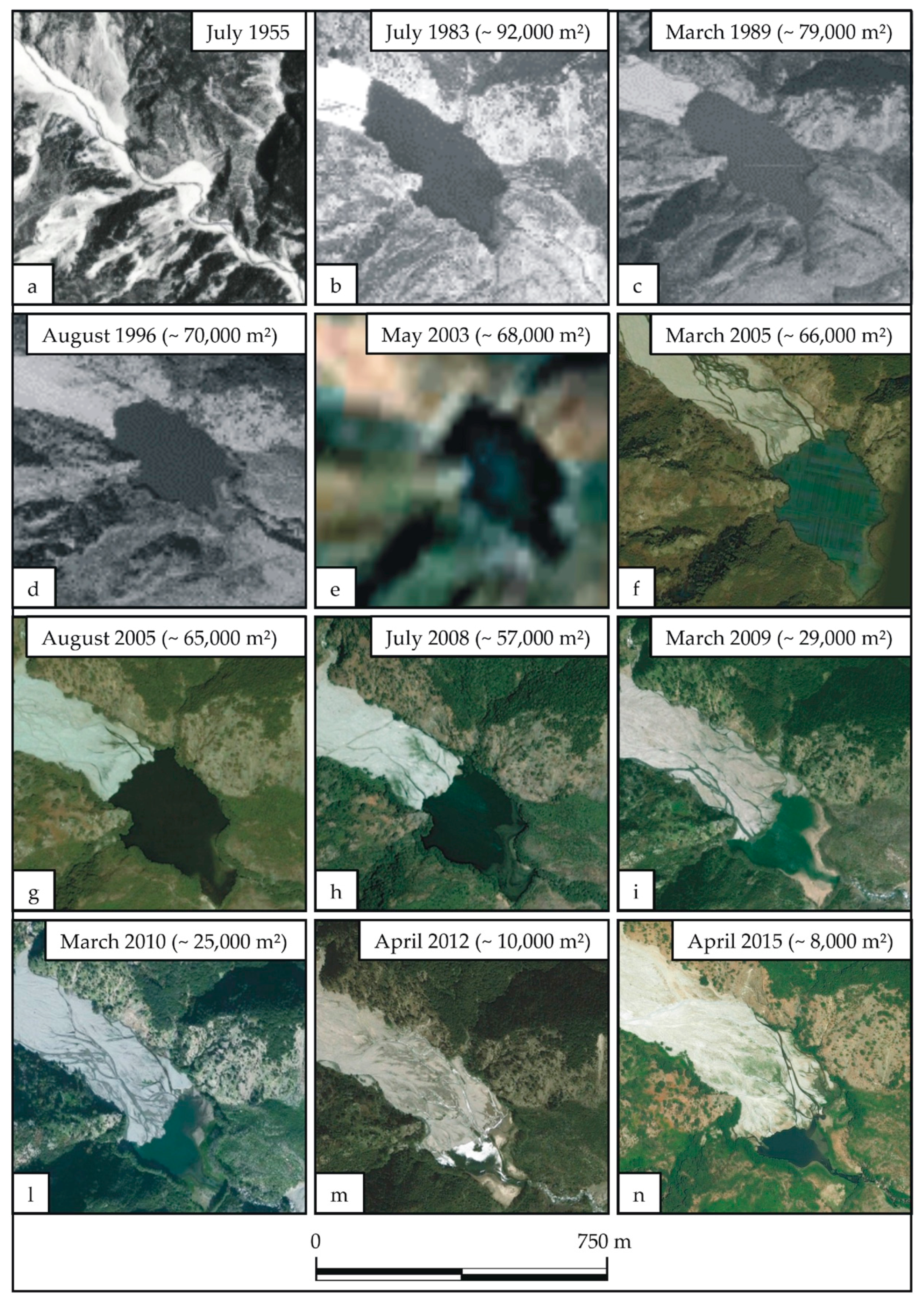
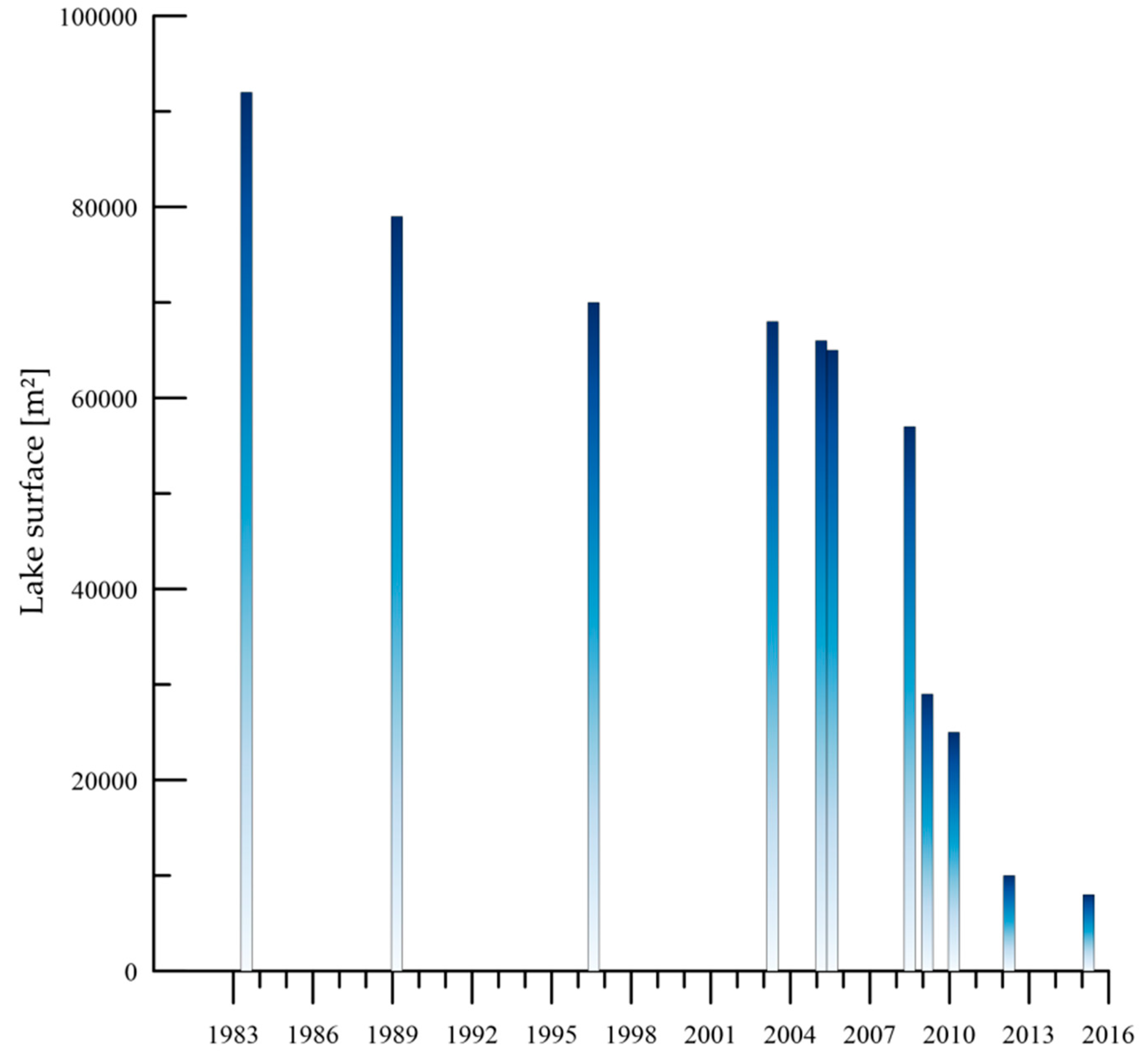
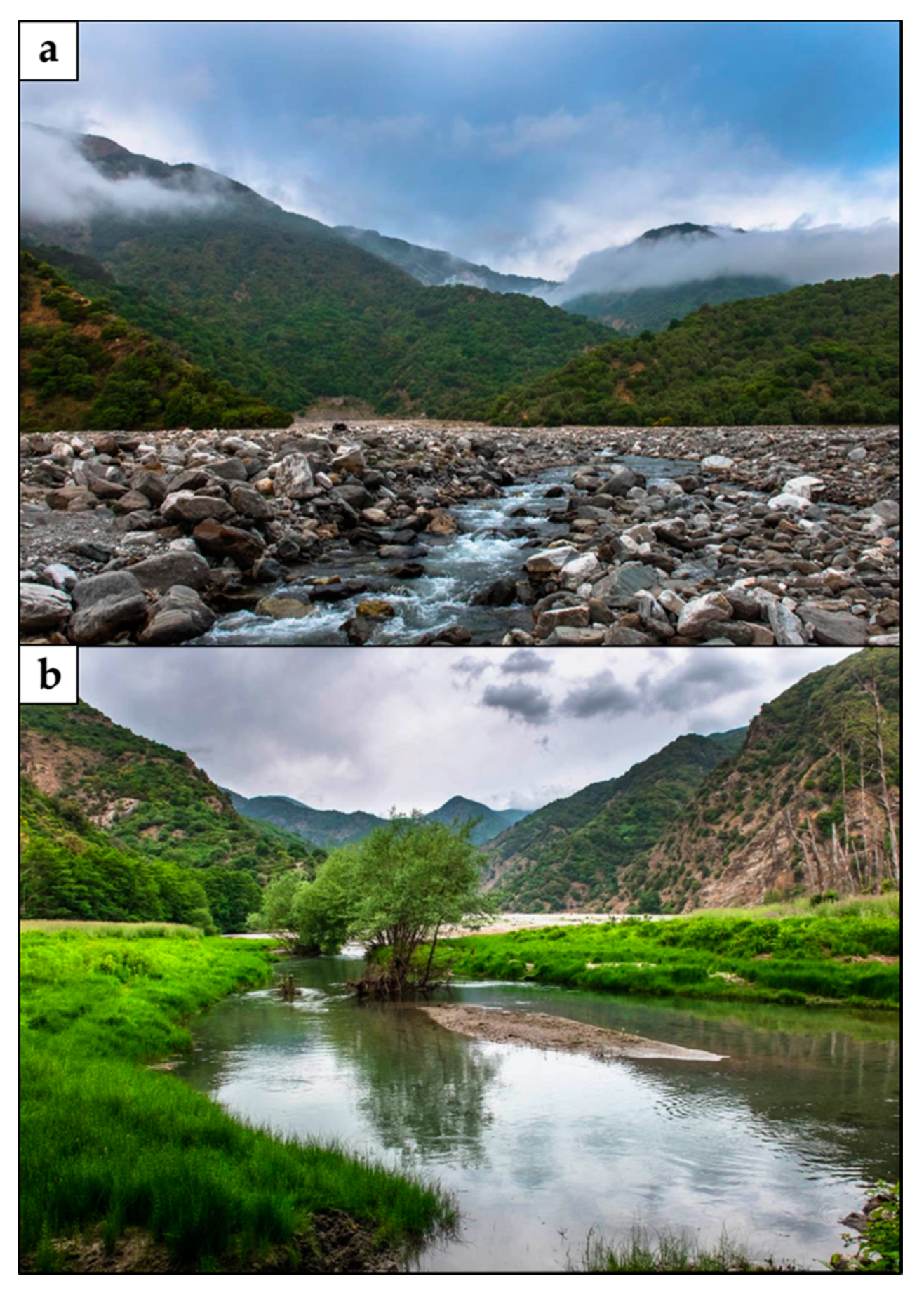
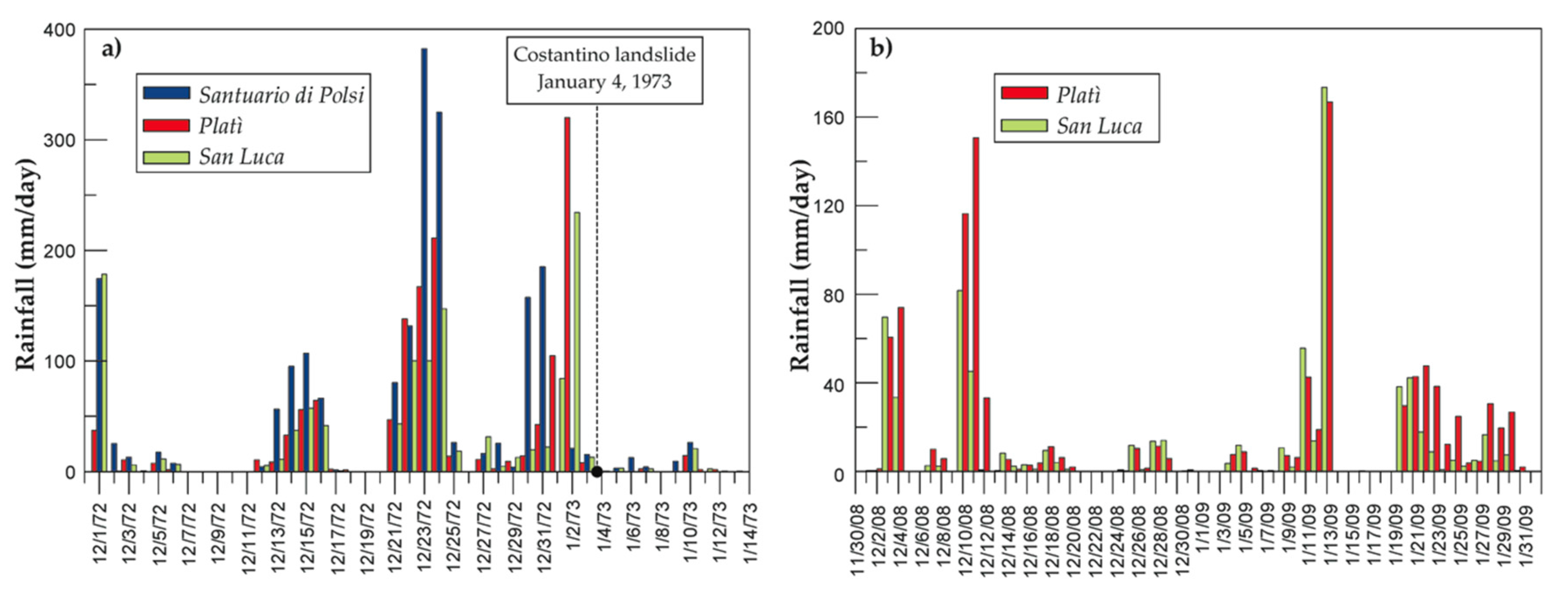
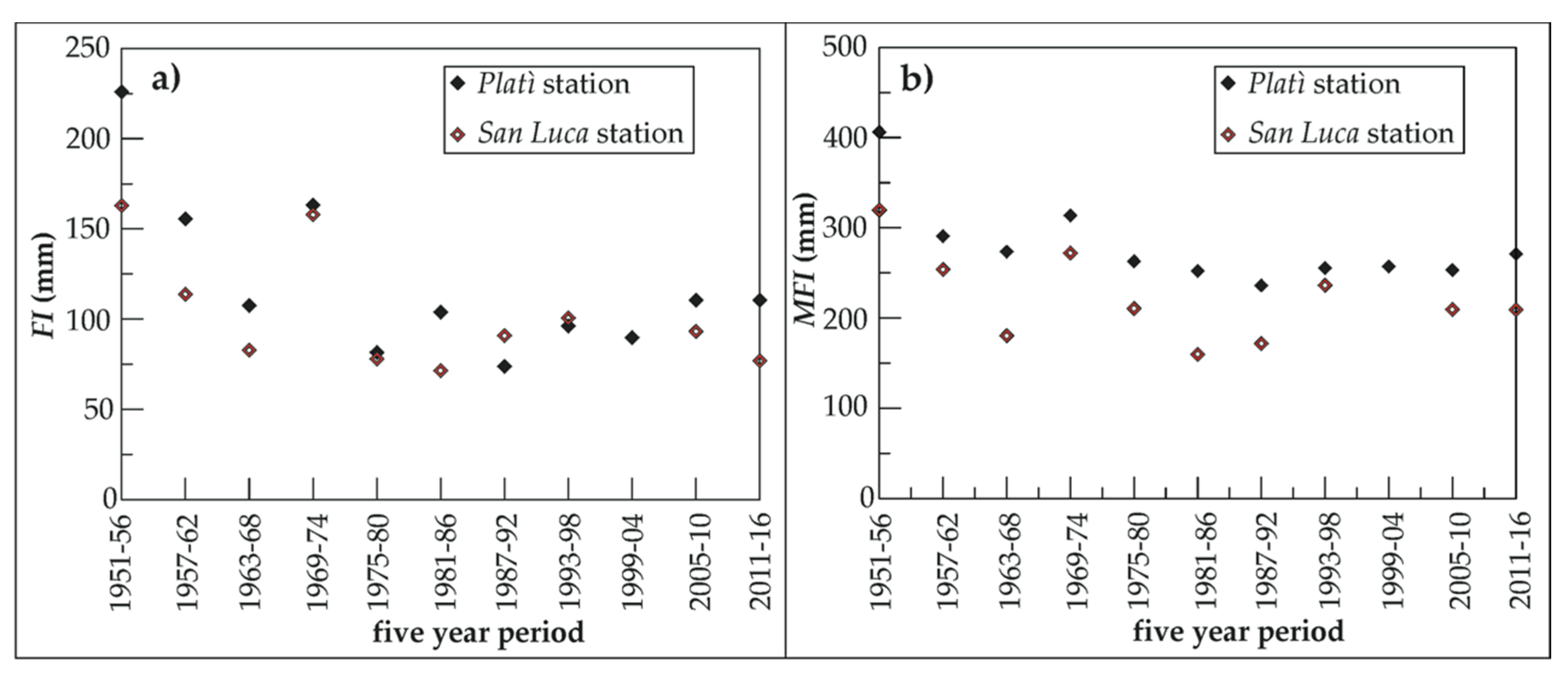
| Station | Code | Type | Elevation (m a.s.l.) | Period | Missing Data |
|---|---|---|---|---|---|
| Platì | 2230 | Rain gauge | 310 | 1920–2016 | 4% |
| San Luca | 2260 | Rain gauge | 250 | 1924–2016 | 5% (no data during 2001–2004) |
| Santuario di Polsi | 2250 | Rain gauge | 786 | 1928–2005 | 27% (no data during 1973–1992) |
| SPI Values | Classification | Abbreviation |
|---|---|---|
| ≥2.0 | Extremely wet | EW |
| 1.5–1.99 | Very wet | VW |
| 1.0–1.49 | Moderately wet | MW |
| 0.99–0 | Normal | N |
| 0–−0.99 | Near Normal | NN |
| −1.0–−1 49 | Moderately drought | MD |
| −1.5–−1.99 | Severe drought | SD |
| ≤−2.0 | Extremely drought | ED |
| Labels of images | Type | Season | Date |
|---|---|---|---|
| a | AP black/white | Summer | July 1955 |
| b | AP black/white | Summer | July 1983 |
| c | OP black/white | Winter | March 1989 |
| d | OP black/white | Summer | August 1996 |
| e | SI colour | Spring | May 2003 |
| f | SI colour | Winter | March 2005 |
| g | SI colour | Summer | August 2005 |
| h | SI colour | Summer | July 2008 |
| i | SI colour | Spring | March 2009 |
| l | SI colour | Winter | March 2010 |
| m | SI colour | Spring | April 2012 |
| n | SI colour | Spring | April 2015 |
© 2017 by the authors. Licensee MDPI, Basel, Switzerland. This article is an open access article distributed under the terms and conditions of the Creative Commons Attribution (CC BY) license (http://creativecommons.org/licenses/by/4.0/).
Share and Cite
Cencetti, C.; Di Matteo, L.; Romeo, S. Analysis of Costantino Landslide Dam Evolution (Southern Italy) by Means of Satellite Images, Aerial Photos, and Climate Data. Geosciences 2017, 7, 30. https://doi.org/10.3390/geosciences7020030
Cencetti C, Di Matteo L, Romeo S. Analysis of Costantino Landslide Dam Evolution (Southern Italy) by Means of Satellite Images, Aerial Photos, and Climate Data. Geosciences. 2017; 7(2):30. https://doi.org/10.3390/geosciences7020030
Chicago/Turabian StyleCencetti, Corrado, Lucio Di Matteo, and Saverio Romeo. 2017. "Analysis of Costantino Landslide Dam Evolution (Southern Italy) by Means of Satellite Images, Aerial Photos, and Climate Data" Geosciences 7, no. 2: 30. https://doi.org/10.3390/geosciences7020030








